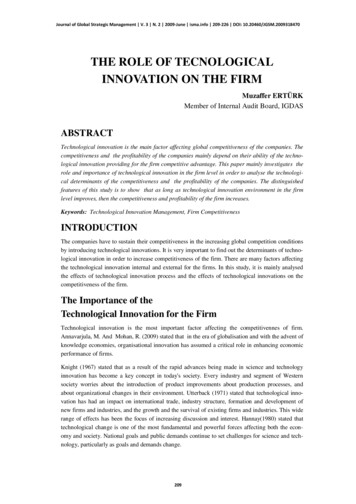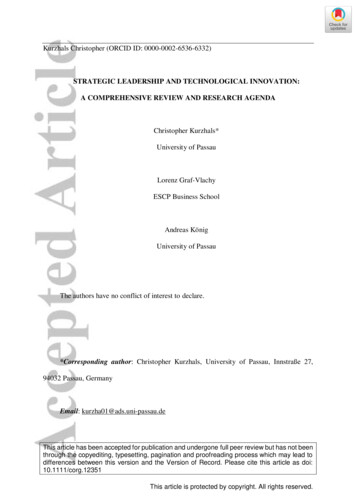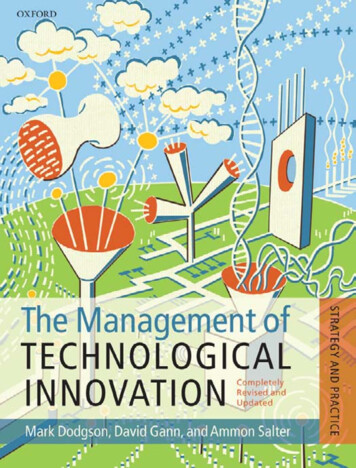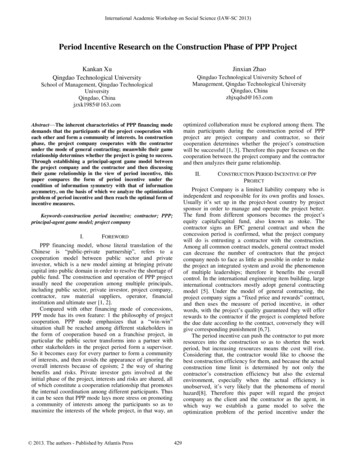
Transcription
Solutions Manual for Strategic Management of Technological Innovation 5th Edition by SchillingFull Download: n-5th-editiInstructor’s ManualStrategic Management of Technological Innovation, 4eInstructor’s Manual1Copyright 2017 McGraw-Hill Education. All rights reserved. No reproduction or distribution without the prior written consent of McGraw-HillEducationFull all chapters instant download please go to Solutions Manual, Test Bank site: downloadlink.org
Instructor’s ManualCHAPTER 1The Importance of Technological InnovationSYNOPSIS OF CHAPTERThe purpose of this chapter is to set the stage for the course by establishing the importance ofmanaging technological innovation strategically.First the chapter overviews the importance of technological innovation for a firm’s competitivesuccess and the advancement of society in general. The chapter points out that 1) many firms arerelying on products developed in the previous three to five years for large portions of their salesand profits; 2) globalization has increased competition putting more pressure on firms tocompete through innovation; 3) advances in information technology have enabled both processimprovements and the efficient generation of product variants which facilitates the execution of adifferentiation strategy at a reasonable cost; and that 3) the residual growth in the GDP can beattributed to technological change. Both the positive and negative effects of technologicalinnovation are described. Advances in food production are an example of the first and pollutionis an example of the latter. Next the innovation funnel is introduced to show students that onaverage 3,000 raw ideas must enter the funnel in order to arrive at 1 successful new productlaunch.Second, the chapter discusses the risks and cost of innovation. On average, many moreinnovation projects fail than succeed. Firms are much more likely to be successful if they have a2Copyright 2017 McGraw-Hill Education. All rights reserved. No reproduction or distribution without the prior written consent of McGraw-HillEducation
Instructor’s Manualwell-crafted strategy for technological innovation. The book is organized to follow thechronological sequence of developing and deploying a rigorous technological innovationstrategy, leading the students through each of the primary aspects that should be considered. Thefinal section of the chapter outlines the layout of the book, reviewing the contribution eachchapter makes to our understanding of the innovation process.TEACHING OBJECTIVES1. Introduce students to the role technological innovation plays in the competitive dynamicsof industries and how technological innovation affects society both positively andnegatively.2. Identify the drivers of technological innovation.3. Discover the attributes of successful innovation strategies including an in-depthunderstanding of the dynamics of innovation, a well-crafted innovation strategy, and awell-developed process for implementing the innovation strategy.LECTURE OUTLINEI)a)OverviewIn many industries technological innovation is now the single most important driver ofcompetitive success and because the pace of innovation has increased many firms now relyon products developed within the prior five years for a large portion of their sales andprofits. This period is reduced to three years for firms in fast-paced industries such ascomputers, software and telecommunications.3Copyright 2017 McGraw-Hill Education. All rights reserved. No reproduction or distribution without the prior written consent of McGraw-HillEducation
Instructor’s Manualb)Innovation is also a very powerful driver of increased effectiveness and efficiency inproducing goods and bringing them to market; firms that do not constantly innovate to maketheir development, production, and distribution processes more effective and efficient arelikely to fall behind their competitors.c)The globalization of markets has played a significant role in increasing the importanceof innovation as a competitive strategy by increasing competitive pressure.d)Advances in information technology have also played a role in driving up the pace ofinnovation. These technologies also help firms to develop and produce more product variantsenabling them to out-focus their competitors.i) For example, Toyota produces 21 different passenger vehicle lines, each withseveral different models and Samsung introduced 52 unique smartphones in 2014.e)Adoption of these new technologies has triggered industry-wide shifts to shorteneddevelopment cycles and more rapid new product introductions.f) The proportion of funds for technological innovation provided by firms relative togovernment funding has been increasing but governments do play a significant role in theinnovation process.II)a.The Impact Of Technological Innovation On SocietyTechnological innovation increases the range of goods and services available to asociety, and the efficiency of providing them. For example, innovation has increased thedevelopment of new medical treatments and the efficiency of food production.i. The Solow residual is the GDP growth represented by technological change.Average world GDP per capita has risen steadily since 1971 and cannot be attributedsolely to the growth of labor and capital inputs.4Copyright 2017 McGraw-Hill Education. All rights reserved. No reproduction or distribution without the prior written consent of McGraw-HillEducation
Instructor’s ManualShow Figure 1.2b.The story is not all positive, however. Sometimes technological innovation results innegative externalities such as pollution and medical technologies can haveunanticipated consequences.III)a.Innovation By Industry: The Importance Of StrategySuccessful innovators have clearly defined innovation strategies and managementprocesses that result in a greater percentage of successful products and shorter developmentcycles.b. How Long Does New Product Development Take? Cycle time varies with the“innovativeness” of the project. Incremental improvements take less time than nextgeneration improvements while new-to-the-world products or technologies take the longest.c.The Innovation Funnel depicts the new product development process as beginning withmany new product ideas going in the wide end and ending with very few projects making itthrough the development process (the bottom of the funnel).Show Figure 1.3IV)The Strategic Management of Technological Innovationa.A firm’s innovation projects should align with its resources and objectives,leverage its core competencies and should help the firm achieve its strategic intent.b.A firm’s organizational structure and control systems should encourage thegeneration and efficient implementation of innovative ideas and a firm’s new productdevelopment processes should maximize the technical and commercial success of eachproject.5Copyright 2017 McGraw-Hill Education. All rights reserved. No reproduction or distribution without the prior written consent of McGraw-HillEducation
Instructor’s Manualc.To achieve these goals, a firm needsi. An in-depth understanding of the dynamics of innovation,ii. A well-crafted innovation strategy,iii. A well-designed processes for implementing the innovation strategy.V)Course OverviewShow Figure 1.4a.Part I focuses on how and why innovation occurs in an industry and why someinnovations rise to dominate others.i. Chapter 2 focuses on the sources of innovation. The questions addressed include:Where do great ideas come from? How can firms harness the power of individualcreativity? What role do customers, government organizations, universities, andalliance networks play in creating innovation?ii. Chapter 3 considers the types and patterns of innovation. The questionsaddressed include: Why are some innovations much harder to create and implementthan others? Why do innovations often diffuse slowly even when they appear tooffer a great advantage? What factors influence the rate at which a technology tendsto improve over time?iii. Chapter 4 focuses on industries characterized by increasing returns. Thequestions addressed include: Why do some industries choose a single dominantstandard rather than enabling multiple standards to coexist? What makes onetechnological innovation rise to dominate all others, even when other seeminglysuperior technologies are on offer? How can a firm avoid being locked out? Is there6Copyright 2017 McGraw-Hill Education. All rights reserved. No reproduction or distribution without the prior written consent of McGraw-HillEducation
Instructor’s Manualanything a firm can do to influence the likelihood of having its technology chosenas the dominant design?iv. Chapter 5 highlights the importance of entry timing. The questions addressedinclude: What are the advantages and disadvantages of being first to market, earlybut-not-first, and late? What determines the optimal timing of entry for a newinnovation?b.Part II focuses on the formulation of technological innovation strategy.i.Chapter 6 reviews the basics of how a firm can assess its current positionand define its strategic direction. The questions addressed include: What are thefirm’s sources of sustainable competitive advantage? Where in the firm’s valuechain do its strengths and weaknesses lie? What are the firm’s core competencies,and how should it leverage and build upon them? What is the firm’s strategic intent-- that is, where do we want to be ten years from now?ii.Chapter 7 examines a variety of methods for choosing among innovationprojects including both quantitative and qualitative methods.iii.Chapter 8 focuses on the important role collaboration can play in thedevelopment of new products and processes. The questions addressed include:Should the firm partner on a particular project or go solo? How does the firmdecide which activities to do in house and which to access through collaborativearrangements? If the firm chooses to work with a partner, how should thepartnership be structured? How does the firm choose and monitor partners?iv.Chapter 9 provides an overview of the options a firm has for appropriatingthe returns to its innovation efforts. The questions addressed include: Are there7Copyright 2017 McGraw-Hill Education. All rights reserved. No reproduction or distribution without the prior written consent of McGraw-HillEducation
Instructor’s Manualever times when it would benefit the firm to not protect its technologicalinnovation so vigorously? How does a firm decide between a wholly proprietary,wholly open, or partially open strategy for protecting its innovation? When will“open” strategies have advantages over wholly proprietary strategies?c.Part III focuses on implementation.i.Chapter 10 examines how an organization’s size and structure influencesits overall rate of innovativeness. The questions addressed include: Do bigger firmsoutperform smaller firms at innovation? How do formalization, standardization, andcentralization impact the likelihood of generating innovative ideas, and theorganization’s ability to implement those ideas quickly and efficiently? Is it possibleto achieve creativity and flexibility at the same time as efficiency and reliability?How do multinational firms decide where to perform their development activities?How do multinational firms coordinate their development activities towards acommon goal when they take place in multiple countries?ii.Chapter 11 highlights a series of “best practices” that have been identifiedin managing the new product development process. The questions addressedinclude: Should new product development processes be performed sequentially or inparallel? What are the advantages and disadvantages of using project champions?What are the benefits and risks of involving customers and/or suppliers in thedevelopment process? What tools can the firm use to improve the effectiveness andefficiency of its new product development processes? How does the firm assesswhether its new product development process is successful?8Copyright 2017 McGraw-Hill Education. All rights reserved. No reproduction or distribution without the prior written consent of McGraw-HillEducation
Instructor’s Manualiii.Chapter 12 builds on the previous chapter by illuminating how teamcomposition and structure will influence project outcomes. The questionsaddressed include: How big should teams be? What are the advantages anddisadvantages of choosing highly diverse team members? Do teams need to becollocated? When should teams be full-time and/or permanent? What type of teamleader and management practices should be used for the team?iv.Chapter 13 reviews innovation deployment options. The questionsaddressed include: How do we accelerate the adoption of the technologicalinnovation? How do we decide whether to use licensing or OEM agreements? Doesit make more sense to use penetration pricing or a market-skimming price? Whatstrategies can the firm use to encourage distributors and complementary goodsproviders to support the innovation?ANSWERS TO DISCUSSION QUESTIONS1.Why is innovation so important for firms to compete in many industries?Innovation enables firms to:-introduce more product and service variations, enabling better market segmentation andpenetration;-improve existing products and services so that they provide better utility to customers;-improve production processes so that products and services can be delivered faster and atbetter prices.9Copyright 2017 McGraw-Hill Education. All rights reserved. No reproduction or distribution without the prior written consent of McGraw-HillEducation
Instructor’s ManualIncreasing globalization has both expanded the potential markets for many firms whilesimultaneously exposing them to greater competition; this has resulted in firms putting moreemphasis on innovation as a lever of competitive differentiation. Furthermore, informationtechnology has enabled such process innovations as CAD/CAM, rapid prototyping, andflexible manufacturing, enabling firms to produce more product variants faster and cheaper.This is a double edged sword: it has enabled product lifecycles to shorten (making rapidinnovation more imperative) while simultaneously improving a firm’s options for innovation.2. What are some of the advantages of technological innovation? Disadvantages?Technological innovation increases knowledge, and makes more options available. On thewhole, evidence suggests that technological innovation has increased GDP and standards ofliving worldwide. Technological innovation also, however, poses some risk of negativeexternalities, e.g.,-pollution;-agricultural and fishing technologies can result in the erosion, elimination of natural habitats,and the depletion of ocean stocks;-medical technologies can result in unanticipated consequences such as antibiotic-resistantstrains of bacteria and viruses, or moral dilemmas regarding the use of genetic modification suchas externalities.10Copyright 2017 McGraw-Hill Education. All rights reserved. No reproduction or distribution without the prior written consent of McGraw-HillEducation
Instructor’s ManualStudents may also suggest that technological innovation may (or has) lead to the loss of diversityin culture and traditions. The instructor may wish to encourage them to debate such risks ofinnovation versus the ways that innovation has enhanced our lives.3. Why do you think so many innovation projects fail to generate an economic return?Innovation is an inherently risky undertaking. Most innovation projects are characterized by bothtechnical uncertainty (will the project result in a technically feasible product or service?) andmarket uncertainty (what features will customer prefer and what will they be willing to pay forthem?) In their eagerness to innovate, firms are at risk of undertaking too many projects,overestimating their potential returns and underestimating their uncertainty. This is compoundedby the fact that many people mistakenly believe that creativity can only be tapped through anunstructured process, when in fact innovation is most powerful and has a greater likelihood ofsuccess when it is planned and implemented strategically.11Copyright 2017 McGraw-Hill Education. All rights reserved. No reproduction or distribution without the prior written consent of McGraw-HillEducation
Instructor’s ManualCHAPTER 2Sources of InnovationSYNOPSIS OF CHAPTERIn this chapter we discuss the role of creativity as the underlying process for the generation ofnovel and useful ideas. Individual creativity is considered to a function of intellectual abilities,knowledge, thinking styles, personality traits, intrinsic motivation and environment. Firmcreativity is more than the sum of member creativity. Firm creativity is also a function of theorganizational structure and the strategic management approach employed.The chapter moves on to explore how creativity is transformed into innovative outcomes by theseparate components of the innovation system (e.g., individuals, firms, etc) and the linkagesbetween the different components.The last part of the chapter focuses on the role of innovation networks in new product/processdevelopment. Firms are most likely to collaborate with customers, suppliers, and universities,though they also may collaborate with competitors, producers of complements, governmentlaboratories, nonprofit organizations, and other research institutions. Emphasis is placed ondeveloping an understanding of technological clusters including how they are formed and thebenefits associated with them. The role of knowledge transfer in the creation of clusters isdemonstrated in the context of Silicon Valley.12Copyright 2017 McGraw-Hill Education. All rights reserved. No reproduction or distribution without the prior written consent of McGraw-HillEducation
Instructor’s ManualTEACHING OBJECTIVES1. To help students understand the relationship between creativity and innovation.2. To explore, quantitatively and qualitatively, the role played by individuals, firms,universities, governments, and non-profits in innovation.3. The chapter highlights the role of collaborative networks in innovation, includingtechnological spillovers, and technology clusters.LECTURE OUTLINEVI)Overviewa.Innovation can arise from many different sources including individuals, firms,universities, government laboratories and incubators, and private non-profit organizations.b.Firms are well suited to innovation activities because they are highly motivated by theneed to remain competitive and because have the management systems needed to organizetheir resources to achieve an organizations’ objectives.c.An even more important source of innovation is the networks that link innovatorstogether. These networks leverage a broader range of knowledge and resources than anindividual entity could.VII)a.CreativityCreativity is defined as the ability to produce work that is useful and novel (i.e. differentand surprising when compared to prior work). The most creative works are novel at theindividual producer level, the local audience level, and the broader societal level. When aproduct is novel to its creator but know to everyone else it is referred to as a reinvention.13Copyright 2017 McGraw-Hill Education. All rights reserved. No reproduction or distribution without the prior written consent of McGraw-HillEducation
Instructor’s Manualb.Individual creativity is a function of intellectual abilities, knowledge, style of thinking,personality, motivation, and environment. Researchers have argued that the mostimportant capability is the ability to look at problems in unconventional ways.i. Too much knowledge can result in an inability to think beyond the existing logicand paradigms of a field while too little knowledge can lead to trivial contributionsii. The most creative individuals can distinguish important problems fromunimportant ones.iii. Self-efficacy, tolerance for ambiguity, and a willingness to overcome obstaclesand take reasonable risks are the personality traits most important for creativity.iv. Intrinsic motivation has also been shown to be very important for creativity.c.Organizational creativity is a function of creativity of the individuals within theorganization and a variety of social processes and contextual factors that shape the waythose individuals interact and behave.i. The creativity of individuals can be amplified or thwarted by an organization’sstructure, routines, and incentives. Common methods of tapping employeecreativity include 1) the suggestion box, 2) idea management systems (Google,Honda, BankOne).d.Idea collection systems such as suggestion boxes, or idea management systems are only afirst step. Managers can be trained to signal (through verbal and nonverbal cues) that eachemployees thinking and autonomy is respected. Employees can also be trained to usecreativity tools such as using analogies or developing alternative scenarios. You may wantto discuss the various ways that Google inspires creativity as described in the Theory inAction box.14Copyright 2017 McGraw-Hill Education. All rights reserved. No reproduction or distribution without the prior written consent of McGraw-HillEducation
Instructor’s ManualIII. Translating Creativity Into Innovationa.Innovation occurs when new ideas are implemented into some useful form (e.g. newproduct or process).b.The Inventor has been the focus of much study and there is significant disagreementover whether inventors are born or made. It is also important to note that the qualities thatmake an individual inventive do not necessarily make that individual entrepreneurial.i. Inventors are often portrayed as eccentric and doggedly persistent scientists. Oneten-year study of inventors showed that the most successful inventors:1. Have mastered the basic tools and operations of the field in which theyinvent, but have not specialized solely on that field.2. Are curious, and more interested in problems than solutions.3. Question the assumptions made in previous work in the field.4. Often have the sense that all knowledge is unified. They will seek globalsolutions rather than local solutions, and will be generalists by nature.You may want to raise the example of Dean Kamen (from the Theory inAction) here and ask students how he illustrates these characteristics.c.Users are another important source of innovation. Users are keenly aware of their unmetneeds and have the greatest motivation to find ways to meet those needs. You may want tobring up how doctors started using Superglue to repair skin in emergency situations asdiscussed in text. Innovation by users can blossom into wholly new industries, as demonstratedby the snowboarding example provided in the Theory in Action box.15Copyright 2017 McGraw-Hill Education. All rights reserved. No reproduction or distribution without the prior written consent of McGraw-HillEducation
Chapter 2Sources of Innovation
Getting an Inside Look:Given Imaging’s Camera Pill The Camera Pill: A capsule that is swallowed by patientthat broadcasts images of the small intestine Invented by Gavriel Iddan & team of scientists Iddan was a missile engineer – no medical background Project initiated by Dr. Scapa, a gastroenterologist Iddan applied guided missile concept to problem of viewing thesmall intestine Developing the Camera Pill Many hurdles to overcome: size, image quality, battery life Formed partnership with Gavriel Meron (CEO of Applitec) for capitalto commercialize Formed partnership with team of scientists lead by Dr. C. Paul Swainto combine complementary knowledge Resulted in highly successful, revolutionary product.2-3
Getting an Inside Look:Given Imaging’s Camera PillDiscussion Questions:1. What factors do you think enabled Iddan, an engineer with nomedical background, to pioneer the development of wirelessendoscopy?2. To what degree would you characterize Given’s development ofthe camera pill as “science-push” versus “demand-pull”?3. What were the advantages and disadvantages of Iddan andMeron collaborating with Dr. Swain’s team?4. What were the advantages and disadvantages of Given beingowned by Medtronic?2-4
Overview Innovation can arise from many different sources and thelinkages between them.2-5
Creativity Creativity: The ability to produce work that isuseful and novel. Individual creativity is a function of: Intellectual abilities (e.g., ability to articulate ideas) Knowledge (e.g., understand field, but not wed toparadigms) Style of thinking (e.g., choose to think in novel ways) Personality (e.g., confidence in own capabilities) Motivation (e.g., rely on intrinsic motivation) Environment (e.g., support and rewards for creative ideas)2-6
Creativity Organizational Creativity is a function of: Creativity of individuals within the organization Social processes and contextual factors that shape howthose individuals interact and behave Methods of encouraging/tapping organizationalcreativity: Idea collection systems (e.g., suggestion box; Google’s ideamanagement system) Creativity training programs Culture that encourages (but doesn’t directly pay for)creativity.2-7
Theory in Action Inspiring Innovation at Google Google uses a range of formal and informalmechanisms to encourage its employees toinnovate, including: 20% Time (all engineers are encouraged to spend 20% oftheir time working on their own projects)Recognition awardsGoogle Founders’ AwardsAd sense Ideas ContestInnovation reviews2-8
Translating Creativity into InnovationInnovation is the implementation of creative ideasinto some new device or process.Requires combining creativity with resources andexpertise.Inventors One ten-year study found that inventors typically:1.2.3.4. Have mastered the basic tools and operations of the field in which theyinvent, but they will have not specialized solely on that field.Are curious, and more interested in problems than solutions.Question the assumptions made in previous work in the field.Often have the sense that all knowledge is unified. They will seek globalsolutions rather than local solutions, and will be generalists by natureSuch individuals may develop many new devices or processesbut commercialize few.2-9
Theory in Action Dean Kamen The Segway HT: A self-balancing, two-wheeledscooter. Invented by Dean Kamen Described as tireless and eclecticKamen held more than 150 U.S. and foreign patentsHas received numerous awards and honorary degreesNever graduated from collegeTo Kamen, the solution was not to come up with a newanswer to a known problem, but to instead reformulate theproblem2-10
Transforming Creativity intoInnovation Innovation by Users Users have a deep understanding of their ownneeds, and motivation to fulfill them. While manufacturers typically create innovations toprofit from their sale, user innovators often initiallycreate innovations purely for their own use. E.g., Laser sailboat developed by Olympic sailors;Indermil tissue adhesive based on Superglue; earlysnowboards2-11
Theory In Action The Birth of the Snowboarding Industry First snowboards not developed by sports equipmentmanufacturers; rather they were developed by individualsseeking new ways of gliding over snow Tom Sims made his first “ski board” in wood shop class. Sherman Poppen made a “snurfer” as a toy for his daughter – laterheld “snurfing” contests Jake Burton added rubber straps to snurfer to act as bindings By 2014 there were approximately 7.3 million snowboarders inthe United States2-12
Transforming Creativity into Innovation Research and Development by Firms Research refers to both basic and applied research. Basic research aims at increasing understanding of a topic or fieldwithout an immediate commercial application in mind. Applied research aims at increasing understanding of a topic orfield to meet a specific need. Development refers to activities that apply knowledge toproduce useful devices, materials, or processes.2-13
Transforming Creativity into Innovation Research and Development by Firms Science Push approaches suggest that innovationproceeds linearly: Scientific discovery invention manufacturing marketing Demand Pull approaches argued that innovationoriginates with unmet customer need: Customer suggestions invention manufacturing Most current research argues that innovation is notso simple, and may originate from a variety ofsources and follow a variety of paths.2-14
Transforming Creativity into Innovation Firm Linkages with Customers, Suppliers, Competitors, andComplementors Most frequent collaborations are between firm and their customers,suppliers, and local universities.2-15
Transforming Creativity into Innovation Firm Linkages with Customers, Suppliers,Competitors, and Complementors External versus Internal Sourcing of Innovation External and internal sources are complements Firms with in-house R&D also heaviest users of externalcollaboration networks In-house R&D may help firm build absorptive capacity thatenables it to better use information obtained externally.2-16
Transforming Creativity into Innovation Universities and Government-Funded Research Universities Many universities encourage research that leads to usefulinnovations Bayh-Dole Act of 1980 allows universities to collect royaltieson inventions funded with taxpayer dollars Led to rapid increase in establishment of technology-transferoffices. Revenues from university inventions are still very small, butuniversities also contribute to innovation through publicationof research results.2-17
Transforming Creativity into Innovation Universities and Government-Funded Research Governments invest in research through: Their own laboratories Science parks and incubators Grants for other p
IV) The Strategic Management of Technological Innovation a. A firm's innovation projects should align with its resources and objectives, leverage its core competencies and should help the firm achieve its strategic intent. b. A firm's organizational structure and control systems should encourage the










